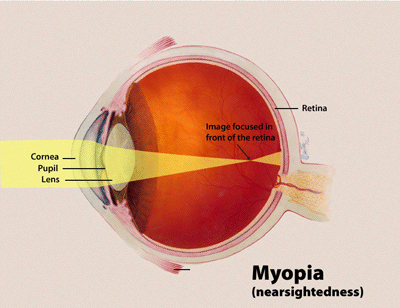Myopia 6

A number sign (#) is used with this entry because of evidence that myopia-6 (MYP6) is caused by heterozygous mutation in the SCO2 gene (604272) on chromosome 22q13.
DescriptionMyopia, or nearsightedness, is a refractive error of the eye. Light rays from a distant object are focused in front of the retina and those from a near object are focused in the retina; therefore distant objects are blurry and near objects are clear (summary by Kaiser et al., 2004).
For a discussion of genetic heterogeneity of susceptibility to myopia, see 160700.
MappingStambolian et al. (2004) sought to identify a myopia susceptibility gene related to mild/moderate myopia, which is a very common disorder particularly in Chinese and Japanese populations (Saw et al., 1996) and Ashkenazi Jews. An increased susceptibility is especially prevalent in Orthodox Jewish males. Stambolian et al. (2004) did cycloplegic and manifest refraction in 44 large American families of Ashkenazi Jewish descent, each with at least 2 affected sibs. Individuals with at least -1.00 diopter or lower in each meridian of both eyes were classified as myopic. A maximum multipoint parametric heterogeneity lod (hlod) score of 3.54 was observed at marker D22S685. The parametric multipoint hlod scores exceeded 3.0 for a 4-cM interval. Linkage results indicated a genetic factor at 22q12.
Klein et al. (2007) conducted nonparametric sib-pair and genomewide linkage analyses on ocular refraction, adjusting for age, education, and nuclear sclerosis, in 834 sib pairs in 486 extended pedigrees in the Beaver Dam Eye Study. They found linkage to the 22q region (multipoint, p = 0.0033), replicating the findings of Stambolian et al. (2004).
Molecular GeneticsIn a large 4-generation family in which 9 members had high-grade myopia, with an average spherical refractive error of -22.00D, Tran-Viet et al. (2013) performed exome sequencing and identified a heterozygous nonsense mutation in the SCO2 gene (Q53X; 604272.0001) that segregated with disease and was not found in 1,000 control samples. Sequencing of SCO2 in an additional 140 high-grade myopia patients revealed 3 heterozygous variants in 3 patients (e.g., 604272.0002 and 604272.0009). Noting that compound heterozygosity for SCO2 mutations has been shown to cause a COX-deficient form of fatal infantile cardioencephalomyopathy (604377), Tran-Viet et al. (2013) commented that neonatal death precludes investigation of an associated clinical ocular phenotype such as refractive error, and that further investigation of the phenotypic intersection of myopia and cardioencephalopathy was warranted.